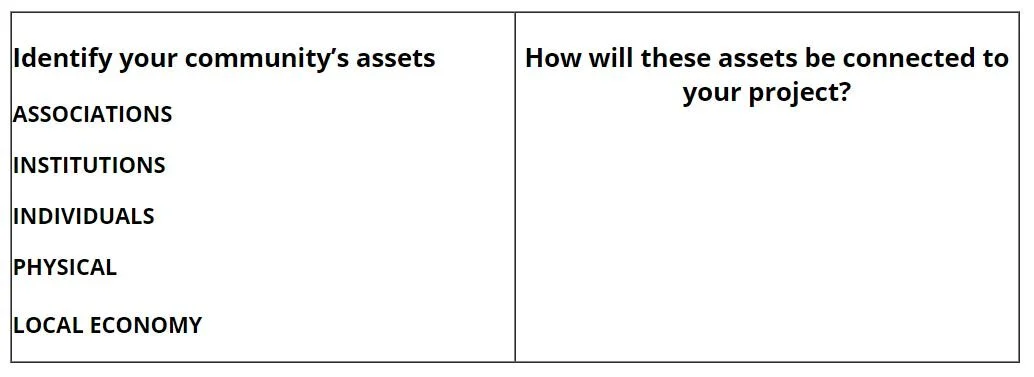
COMMUNITY DEVELOPMENT CERTIFICATE
Module 4: Asset-Mapping
In the Asset Based Community Development approach, several methods are used to identify the strengths of a community. Once identified, these strengths serve as the foundation in building a community driven intervention or program. In this module, we discuss a method called asset-mapping.
Asset-Mapping
Before describing the process of “asset mapping,” two different perspectives should be outlined. One perspective lends to the social service model, and the other lends to the community-building model. A “needs” perspective sees the target community as fundamentally deficient. Thinkers whose worldview is defined by this perspective see only the overwhelming examples of what needs to be fixed, rather than what is functioning well. This outlook of brokenness and insufficiency creates a need for service providers to control the terms of development. When developers dictate the development path, community members either end up dissatisfied or dependent.(1)
If a developer were to create a neighborhood needs map of Chicago’s West Side (an area in which Kretzmann and McKnight have done quite a bit of community organizing), the map might pictorially show clusters of unemployment and truancy here, gangs and slum housing there, all mixed amongst broken families, child abuse, crime, graffiti, mental disability, illiteracy, welfare recipients, dropouts, and teenage pregnancy.
If an “asset” or “capacity-based” perspective is used instead, the developer can see past the poverty to the valuable yet untapped potential of the community. Thus, an asset map of Chicago’s West Side might look like this (2):
For a more thorough understanding of the differences between these two perspectives, please read pages 1-3 (stopping at “Mapping the Building Blocks for Regeneration”) here.
The ABCD approach is based on the assumption that producing strong community-based projects arises out of the ability to connect the community’s assets and the organization’s assets. Hence, this equation is used (3):
YOUR COMMUNITY’S ASSETS + YOUR ORGANIZATION’S ASSETS = STRONG COMMUNITY-BASED PROJECTS
To aid developers in enumerating the assets of their community of interest, ABCD suggests filling out a table like this (4):
In examining the organization through which the developers are working, a table like this might be useful(5):
As is evident, asset mapping is much more operational and informative than needs mapping. A needs survey “is basically an effort to count up the emptiness in an individual or a neighborhood.” It “is not useful for community-building because it deals with people as potential clients and consumers.”(6) An asset survey, on the other hand, sees people as citizens and producers. To apply these concepts to real life, Kretzmann and McKnight offer this example:
“Think of a carpenter who has lost one leg in an accident years ago. Clearly, he has a deficiency. However, he also has a skill. If we know he has a missing leg, we cannot build our community with that information. If we know he has a capacity as a wood worker, that information can literally build our community.”(7)
A participant in the previously mentioned study of ABCDs in the North West of England explained this reframing of deficiencies as assets saying that:
“Rather than seeing that experience as their problem, we’re seeing that as their asset in order to support other people because they’ve got an insight into managing that on a day-to-day basis. So it’s looking at, yeah, where that resides in an individual and their own strengths, rather than having an identity around a person who’s got anxiety or depression, saying, well, actually, you know, you’ve got really valuable experiences both of not only services but also negotiating your way through life with that, that you can bring to other people.”(8)
This identification of the individuals, the community, and the organization's assets is essential for Asset-Based Community Development and leads to a more positive and uplifting experience where everyone can feel seen and included.
Footnotes
(1) Kretzmann, J., & McKnight, J. “Introduction to Asset-Mapping.” (2003).
(2) Kretzmann, J., McKnight, J., Dobrowolski, S., Puntenney, D. “Discovering Community Power: A Guide to Mobilizing Local Assets and Your Organization’s Capacity.” Asset-Based Community Development Institute (2005): 15.
(3) Ibid, 3.
(4) Ibid, 17.
(5) Ibid, 21.
(6) Kretzmann, J., & McKnight, J. “Introduction to Asset-Mapping.” (2003): 1.
(7) Ibid.
(8) Harrison, R., Blickem, C., Lamb, J., Kirk, S., & Vassilev, I. “Asset-Based Community Development: Narratives, Practice, and Conditions of Possibility—A Qualitative Study With Community Practitioners.” SAGE Open, (January 2019). https://doi.org/10.1177/2158244018823081..




